The Dieppe Raid- A Canadian Tragedy – Understanding What Went Wrong
In the last post we visited the site of Abbeye d’Ardenne which was the scene of a particularly despicable war crime, the execution of Nova Scotian prisoners of war under the orders of Kurt Meyer. We are now headed to the scene of what some also consider a war crime, but one perpetrated by our own command, the infamous Dieppe Raid. Please join us in trying to find out what went so spectacularly wrong for the Canadians in their first major conflict of WWII.
After spending a number of days at the D-Day sites in Normandy, Liberation Tour 2015 pulled into the surprisingly large little city of Dieppe . That’s not a Yogi Berraism, but my comment on the fact that it was not the sleepy little fishing village portrayed in stories about the Dieppe raid, but a bustling port and tourism centre. Every Canadian schoolchild learns very early on that the Dieppe Raid occupies a unique place in Canadian history. It was here that we suffered our worst defeat in WWII and almost 1,000 young men died in what has been traditionally characterized as a futile exercise where Canadians at Dieppe were essentially used as guinea pigs. Tomorrow we are going to visit the Dieppe sites, but for tonight we have a very nice hotel right under the shadow of the city’s castle walls and facing the broad expanse of beach on the English Channel.
Dieppe
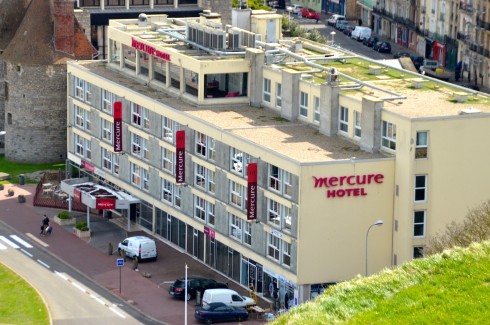
Returning to the hotel after a meal featuring the absolutely finest sole meuniere I have ever tasted,

I noticed this sign which indicated that Dieppe had a far older and more beneficent role in Canadian affairs than most would be aware of.
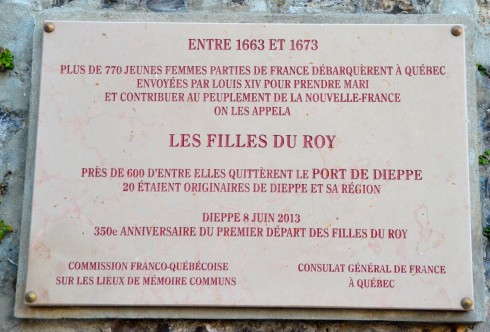
Les filles du Roy were young women who were sent to New France by Louis XIV to help establish and populate the new colony. 2013 marked the 350th anniversary of the first embarkment of over 770 jeunes femmes who formed the backbone of traditional Quebecois pure laine families.
The next morning we met in a small memorial park directly below the castle from where the Nazi commandant of Dieppe watched the raid unfold, gloriously for him, disastrously for us.
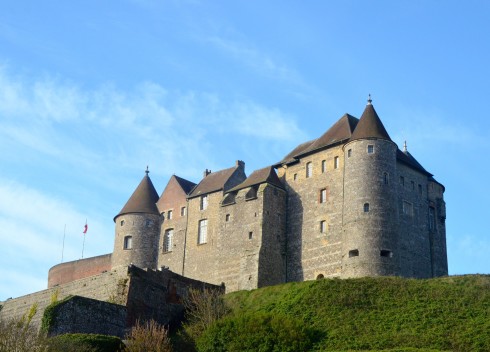
Reasons for the Dieppe Raid
Phil Craig, the tour’s historian explained the reasons for the Dieppe Raid and they made a certain amount of sense. At this time in 1942 the Russians were engaged full on with the German army and taking incredible amounts of casualties. There was no Western Front then and the outcome on the Eastern Front was in doubt. Stalin demanded some action by the Allies to take the heat off his beleaguered armies. Also by this time Churchill and Roosevelt knew that a landing in northern France was all but inevitable at some point, but where, when and how remained three big unanswered questions. The belief was that one of the major ports along the coast would need to be secured in order to facilitate the landing of the men and material necessary to conduct a massive invasion. Testing the strength of the German defences at one of the ports seemed a reasonable idea at the time.
The problem was that the planning was terrible, the recon virtually non-existent and the aerial and naval bombardments too little, too late. To top it off it appears that French double agents may have tipped the Nazis off, so they were extra vigilant. Although Lord Louis Mountbatten is usually named as the scapegoat, this BBC story casts serious doubts on that theory and casts the net wider to Churchill and the Chiefs of Staff. It’s an argument that I won’t resolve in this post so let’s concentrate on what we know happened.
First of all, why Canadians for the Dieppe Raid? That’s easy – because our boys were spoiling for action, having only participated in the doomed defense of Hong Kong so far in the war. Politicians at home wanted credit for Canadian victories as did Canadian commanders. We asked for this fight and we got it, but we really don’t seem to have had much say in the preparation.
Canadians at Dieppe
As Phil moved us from the park to the promenade that fronts the wide shingle beach he explained events as they unfolded on that day in August, 1942. First of all, I was under the impression that the landing had taken place at the base of some cliffs, but here we were looking a good half mile of beach backed by the houses of Dieppe. There were cliffs, but well away from the beaches as you can see by this picture.
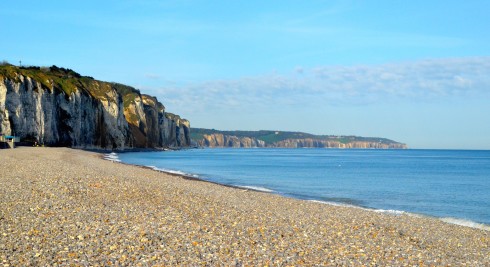
As I’d learned at the D-Day landing sites, there was not just a single point of attack at Dieppe, but five, of which the beach we were standing on was the primary landing spot. Here’s a map of the Dieppe Operation, which is what it was and not just a raid. That word connotes a small hit and run force. Dieppe was anything but small, with over 6,000 men, 237 ships and 74 squadrons of aircraft involved. Looking at the map, we were right at the point where the two red arrows indicate the landing spots of the Royal Hamilton Light Infantry and the Essex Scottish Regiment.
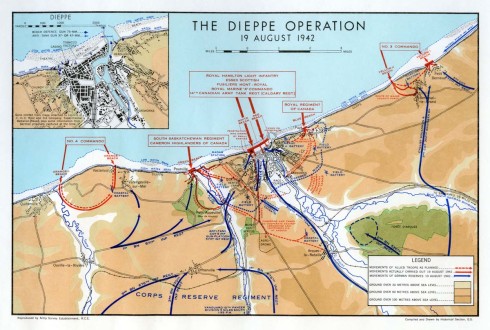
The Dieppe Raid was the first to attempt to land tanks on shore after being ferried as close as possible by carrier boats. It was a total failure and the lack of proper recon was largely responsible. Unlike the D-Day beaches which are flat and sandy, Dieppe is a shingle beach made up of millions of small pebbles that provide no traction for any type of vehicle. On top of that there is a steep incline from shoreline to the beach proper. Here’s what it looks like today.
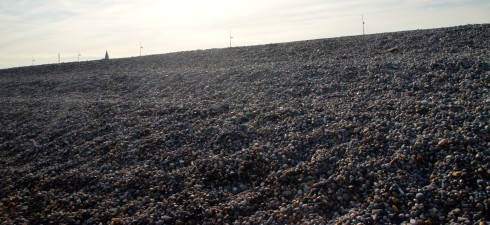
Here’s a picture of disabled tanks and other vehicles at Dieppe on August 19, 1942.
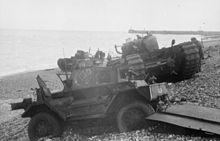
So the tank support the Hamilton’s and Essex’s thought they were going to get turned out not to be. They were more useful as places to hide behind once the murderous crossfire from batteries on the cliffs on both sides of Dieppe opened up. Here’s what a soldier faced after being landed on the beach. He could not see above the ridge of the beach and once he clambered up he was a sitting duck. The beach is quite wide and to get to the protection of the seawall the soldiers had to cross a goodly amount of territory while maneuvering through barbed wire. I had a hard enough time of it just trying to run up as fast as I could with a small pack. For every foot I gained I sank back six inches. I can’t imagine doing it with a full soldier’s pack while under heavy fire, but they did.
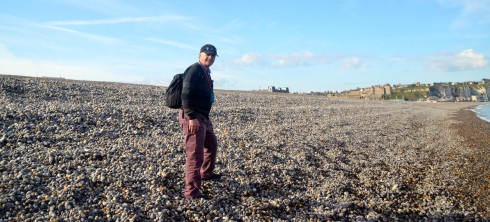
The Hamilton’s had 197 killed that day in Dieppe and the Essex’ 121. Incredibly some of them managed to fight their way into the town proper and engage in house to house fighting before being captured, killed or for a lucky few managing to retreat to the beach for evacuation.
This memorial to the Essex Scottish Regiment is but one of a number in the Dieppe area to various Canadians at Dieppe units that suffered catastrophic losses here.
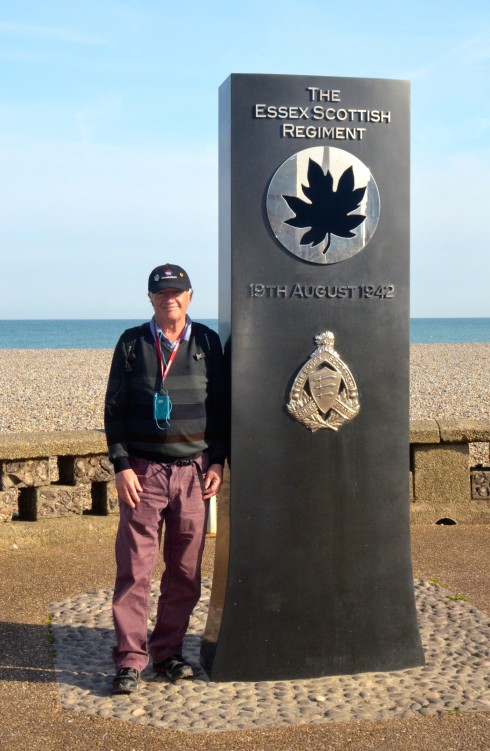
I have indelible memories of reading the story of John Weir Foote V.C. in, I believe, our Grade 5 reader. It was on this very spot that he won his Victoria Cross, the only Chaplain to ever do so. Here is the citation for his medal.
‘Upon landing on the beach under heavy fire he attached himself to the Regimental Aid Post which had been set up in a slight depression on the beach, but which was only sufficient to give cover to men lying down. During the subsequent period of approximately eight hours, while the action continued, this officer not only assisted the Regimental Medical Officer in ministering to the wounded in the Regimental Aid Post, but time and again left this shelter to inject morphine, give first-aid and carry wounded personnel from the open beach to the Regimental Aid Post. On these occasions, with utter disregard for his personal safety, Honorary Captain Foote exposed himself to an inferno of fire and saved many lives by his gallant efforts.
During the action, as the tide went out, the Regimental Aid Post was moved to the shelter of a stranded landing craft. Honorary Captain Foote continued tirelessly and courageously to carry wounded men from the exposed beach to the cover of the landing craft. He also removed wounded from inside the landing craft when ammunition had been set on fire by enemy shells. When landing craft appeared he carried wounded from the Regimental Aid Post to the landing craft through heavy fire. On several occasions this officer had the opportunity to embark but returned to the beach as his chief concern was the care and evacuation of the wounded. He refused a final opportunity to leave the shore, choosing to suffer the fate of the men he had ministered to for over three years.
Honorary Captain Foote personally saved many lives by his efforts and his example inspired all around him. Those who observed him state that the calmness of this heroic officer as he walked about, collecting the wounded on the fire-swept beach will never be forgotten.’
What I found astounding was the fact he chose to stay behind to minister to the other POWs, when he could have safely evacuated. It cost him almost three years of imprisonment. While I am not a religious person I know that it can inspire others to make great sacrifices.
During our visit to Dieppe beach we were joined by Scotsman Allan Learmonth, whose father had been involved in the Dieppe Raid. He had taken the ferry over from Newhaven just to meet with our group. We had a great chat before he cycled off to tour the other Dieppe sites on his own.
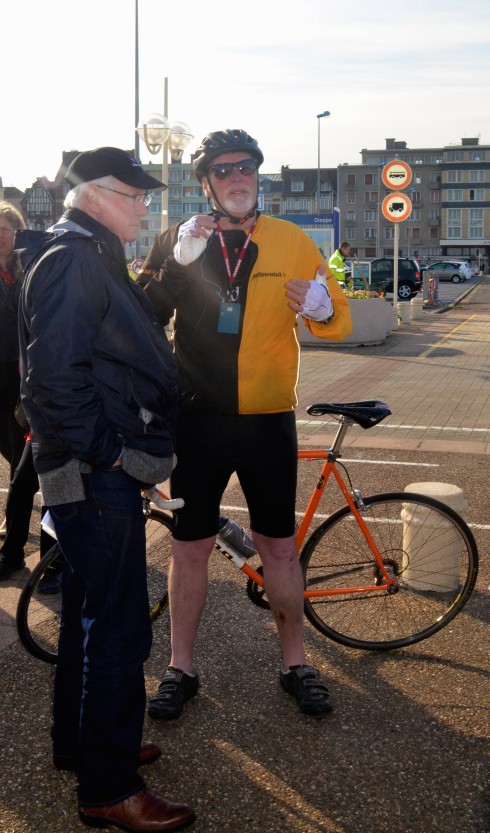
We were now going to get back on the bus and visit Puys and Pourville, two of the outlying areas where Canadians fought and died during the Dieppe Operation. I’ll report on that in Part II of the Dieppe story.

